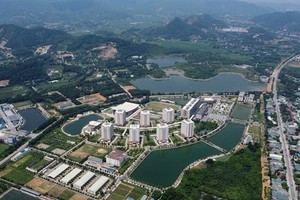 |
Despite the rainfall in the upper catchment areas of hydroelectric reservoirs, there is a need to ramp up their operations to meet the increasing electricity demand. |
Based on data from the National Load Dispatch Center (A0), the extensive heat in the Red River Delta and the Central regions has resulted in a surge in electricity demand across the entire power system. To avoid a recurrence of power shortages, A0 has ramped up the deployment of hydroelectric and thermal power sources to meet the increasing load. Specifically, hydroelectric generation has been boosted by around 32 million kWh while thermal power derived from coal has risen by approximately 20 million kWh. Gas turbine power plants have also contributed around 10-11 million kWh, without resorting to oil-fired power generation.
For instance, on July 3, the total electricity demand across the country reached 831.8 million kWh, up 75.6 million kWh compared to July 2. The highest surge was observed in the Southern region, with an increase of 67.3 million kWh. The Northern region followed with an additional 6 million kWh while the Central region accounted for the remaining increment.
According to the National Center for Hydro-Meteorological Forecasting, the upper catchment areas of hydroelectric reservoirs in the Northern region experienced widespread moderate rain on July 3 and 4, with some areas encountering heavy downpours.
The one-hour heavy rain on the afternoon of July 4 resulted in severe flooding on various roads in Son La Province. The floodwaters swept away the merchandise of local vendors in the 7/11 market.
 |
The one-hour heavy rain on the afternoon of July 4 results in severe flooding on various roads in Son La Province. |
According to the forecast, the rain is expected to continue in the Northern mountainous region until July 6. From the night of July 4 to July 5, a flood wave with a magnitude of 1-3 meters is anticipated in the Northern mountainous and midland areas and the upper reaches of the Red River and Thai Binh River system. The water inflow into the reservoirs in the Northern, Central Highlands, and Southeastern regions is expected to experience a slight increase. However, a decrease in water flow is projected for the North Central and the South Central Coastal regions.
Nevertheless, in the North Central Coast and Central regions, the hot and scorching weather is expected to persist until July 15, with temperatures possibly soaring to 40 degrees Celsius. This prolonged heatwave will continue to drive up the electricity demand.
On July 4, Hoa Binh and the Red River Delta experienced widespread hot weather with temperatures ranging from 35-36 degrees Celsius. In the region stretching from Thanh Hoa to Phu Yen, there were intense heatwaves and scorching conditions, with Tinh Gia District in Thanh Hoa Province recording a temperature of 37.5 degrees Celsius, while Tay Hieu Commune in Nghe An Province reaching 37.2 degrees Celsius.
"The hot weather in the North and the region from Thanh Hoa to Phu Yen will persist on July 5 and is expected to continue for several more days," warns the meteorological agency.
























